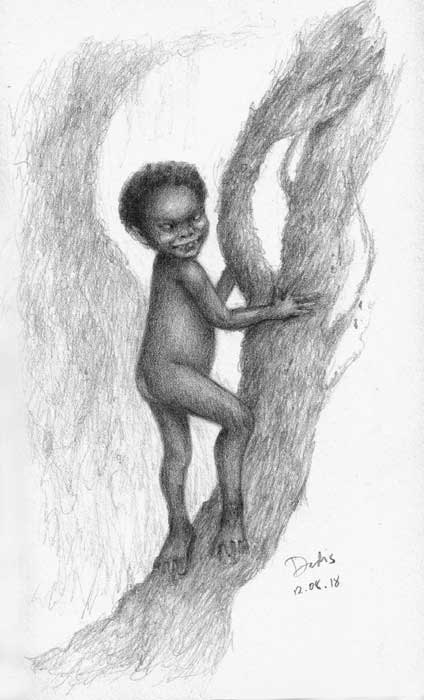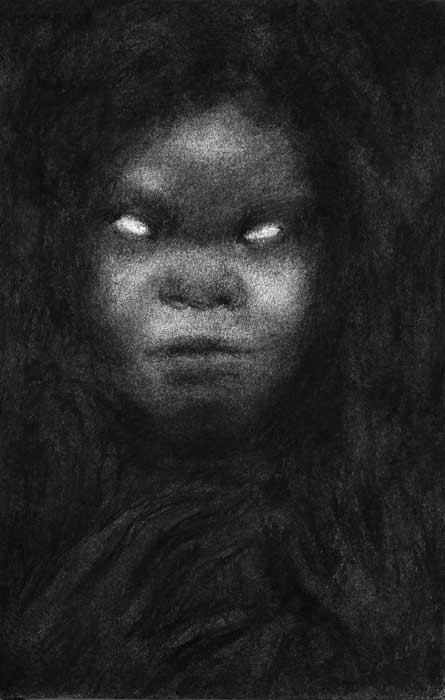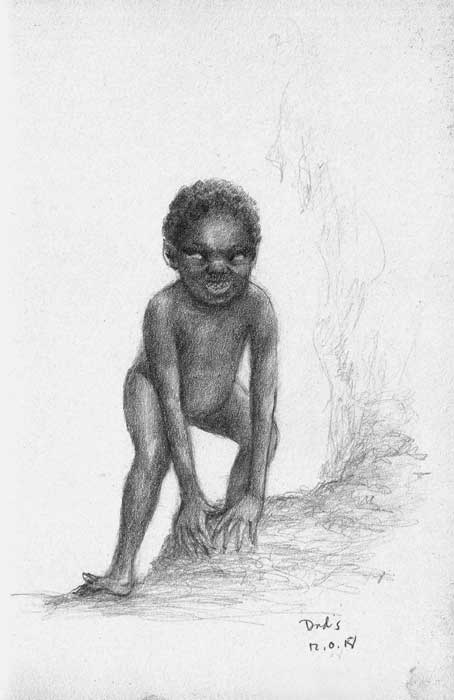THE BIANGONAN is definitely one of the most horrifying beings I’ve documented in Philippine Mythology & Folklore. I was lucky enough to visit the Batak people of Palawan in March 2018 where I learned about a few folk tales and myths that I had not encountered previously. The one that stuck with me most was the description and recounted stories of the Biangonan.

Art By: Charisse ‘Dadis’ Melliza
https://www.instagram.com/thefaeriepatch/
BATAK PEOPLE
The Batak people are believed to be one of the first inhabitants of the Philippines. The name, “Batak” is said to be a Cuyunon term for “mountain people”. The Batak used to be semi-nomadic hunter-gatherers, collecting foods from the forest and rivers such as honey, tubers, fruits, leaves, animals, birds, fish, crustaceans, mollusks, rattans, nuts and seeds. The Batak used to live in the lowland areas, but as lowland Filipino villages were established by pioneer settlers from Cuyo, Luzon and the Visayas back in the nineteenth century, they were pushed into more permanent and unsustainable villages. The Batak are considered by anthropologists to be closely related to the Aeta of Central Luzon, another group that are classified under the “negrito” misnomer.
The Batak tribe in Kalakwasan, Sitio Tanabag, Palawan are the smallest tribe in Palawan, with just 49 families left – less than 300 people – they’re slowly disappearing.
BIANGONAN
I have been studying the beings and spirits of Philippine Mythology for almost 14 years, and I had to admit that I’d never heard of the Biangonan. It doesn’t appear in any of the Maximo Ramos documentation, and there were no recounted tales in the work of Eugenio, Jocano, or the plethora of anthropological studies that exist about Philippine beliefs. The day before visiting the tribe, I had spent an afternoon at the Palawan Museum in Puerto Princesa, pouring over the studies held in their library and making notes about deities and spirits. While discussing folklore with my guide, the beliefs being related back to me were familiar from what I had previously learned. It was only when I stated my interest in Philippine Mythology & Folklore started with the aswang, that she volunteered stories of the Biangonan. At first it was relayed to me as a silly superstition and somewhat of a joke (as often happens when I speak with people on this topic), but the conversation turned more serious when she discovered my interest was genuine and honest.
The Biangonan is described as a small human with black skin, kinky dark hair, and feet pointing backwards. They can sometimes be found climbing through the tallest trees. It can transform into a human or a pig, where it will use this guise to sneak into a village and steal a pig or a human for its consumption. When villagers detect a rotting smell, they know a Biangonan is near. They will light a large fire which is believed to ward it off. The Biangonan devours every part of the human they steal from the village, but will leave the jaw bone of the victim hanging in a tree.

Art By: Charisse ‘Dadis’ Melliza
https://www.instagram.com/thefaeriepatch/
It appears that nobody is safe from the Biangonan as the village I visited has attributed it to the not so distant disappearance of their Babaylan. She could not be found for weeks, until her jaw bone was discovered hanging in a tree. Large fires were burned for days afterwards for when the village has nothing but the moonlight and dying embers to light the dark jungle, thoughts of the Biangonan will creep into their minds. I imagine if any of us hear something scurrying in the trees tonight, the Biangonan will most certainly be part of our imagined demise.
After returning to Canada, I did manage to find an entry about the Biangonan in “The Encyclopedia of Philippine Folk Beliefs and Customs Volume 1” taken from the paper by Jose A. Samson called “The Bataks Of Sumurod And Kalakuasan”,UNITAS, Volume 40, No. 1, (March, 1967).
“The Batak believe that biangonan are small people possessed of talons who hide in rocks and trees. When they attack their victims, they utter long piercing shrieks that paralyze their victims. Then they tear and claw at the throat of the helpless man.”

Art By: Charisse ‘Dadis’ Melliza
https://www.instagram.com/thefaeriepatch/
BEINGS WITH BACKWARDS FEET: An Ancient Belief?
“Perhaps the trait most widely ascribed to unknown hominids is that of having reversed feet, that is, their feet are said to point to the rear when the creatures walk forwards. In the Old World the notion that various species of wild men and supernatural creatures have reversed feet is probably ancient and widespread (Kirtley, 1964, p77)”
When I heard the description of the Biangonan and its backwards feet, I was immediately reminded of the Alan belief from the Itneg people of Abra, Luzon. I’ve done enough general comparative studies to know which migration brought certain aspects to Philippine Beliefs. However, I was stumped with these mythical beings both having backwards feet. While the Batak people represent one of the earliest migrations to the Philippines, their folklore has been heavily influenced by the subsequent Malay migrations and Indianized beleifs. On the other hand, the Itneg people are a more ‘pure’ representation of the Austronesian language group that may have arrived in the Philippine archipelago before Hinduism spread to SE Asia. Instances like these require me to conduct a broader look.
In India, Bhoots are able to alter and assume forms of various animals at will, but are usually seen in human form. However, their feet often reveal them to be ghosts, as they are backwards. Also from this area is the Churel, which is described as extremely ugly with saggy breasts, a black tongue, and thick rough lips although sometimes she is reported to have no mouth at all. She may have a pot belly, claw-like hands, and scruffy, long pubic-like hair. They are also described to have pig faces with large fangs or human-like faces with sharp tusks and long, wild hair. She is sometimes described as having a white front and a black back but she invariably has her feet turned backward and sometimes, she roams naked. According to the poem Lalla Radha and The Churel, she takes the form of a lovely woman with alluring eyes but her appearance is marred by her backward turned feet.
The Curupira lives in the forests of Brazil and uses its backward feet to create footprints that lead to its starting point, thus making hunters and travelers confused. Besides that, it can also create illusions and produce a sound that’s like a high pitched whistle, in order to scare and drive its victim to madness. It is common to portray a Curupira riding a collared peccary, much like another Brazilian creature called Caipora.
Krivopete: Wild women with backward-facing feet in Slovenian folk narrative tradition.
Pliny the Elder in Naturalis Historia, VII. Chapter 2 mentions, “Beyond the other Scythian Anthropophagi, there is a country called Abarimon, situated in a certain great valley of Mount Imaus the inhabitants of which are a savage race, whose feet are turned backwards, relatively to their legs:”
Aulus Gellius in Attic Nights, IX. Chapter 4 states, “That there are also in the same region [Scythia] other men, of marvellous swiftness, whose feet are turned backwards and do not point forward, as in the rest of mankind.”
Near a mountain which is called Nulo there live men whose feet are turned backwards and have eight toes on each foot. (Megasthenes, Indica, Fragment XXXB. Solin 52: 26-30)
The Antipodes in Libya have the soles of their feet twisted behind their legs, and eight toes on each foot. (Isidore of Seville, Etymologie , XI iii, 24).
It is sometimes rumoured that the cryptozoological Yeti of Nepal has backward turned feet.
In conclusion, it may very well be that the similarity between the Alan of the Itneg people and the Biangonan of the Batak people are evolved from similar influences stemming from a belief so ancient that the earliest understanding and tales may be lost deep within pre-history and the earliest human migrations.
References:
Baumgarten, Siegmund Jakob, 1706-1757. A Supplement to the English Universal History: Lately Published In London: Containing … Remarks And Annotations On the Universal History, Designed As an Improvement And Illustration of That Work … London: E. Dilly, 1760.
Gellius, Aulus. The Attic Nights of Aulus Gellius. Rev. [ed.] Cambridge, Mass.: Harvard University Press , 1946.
Isidore of Seville, 560-636. Entymologies. Trans. Stephen A. Barney, W.J. Lewis, et al. Cambridge, MA: Cambridge University Press, 2006.
Megasthenes. Ancient India As Described by Megasthenês And Arrian. Calcutta: Thacker, Spink, 1877.
Pliny, the Elder. The Natural History of Pliny. London: G. Bell & sons, 1856.
Kirtley, Bacil F. “Unknown Hominids and New World Legends”. Western Folklore, Vol. 23, No. 2. Apr., 1964, p77-90.
Demetrio, Francisco “Encyclopedia of Philippine Folk Beliefs Volume 1 p620, Xavier University Press, 1991
Jordan Clark is a Canadian born descendant of Scottish immigrants living on the homelands of the Lekwungen speaking peoples. His interest in Philippine myth and folklore began in 2004. Finding it difficult to track down resources on the topic, he founded The Aswang Project in 2006. Shortly after, he embarked on a 5 year journey, along with producing partner Cheryl Anne del Rosario, to make the 2011 feature length documentary THE ASWANG PHENOMENON – an exploration of the aswang myth and its effects on Philippine society. In 2015 he directed “The Creatures of Philippine Mythology” web-series, which features 3 folkloric beings from the Philippines – the TIKBALANG, KAPRE and BAKUNAWA. Episodes are available to watch on YouTube. Jordan recently oversaw the editing for the English language release of Ferdinand Blumentritt’s DICCIONARIO MITOLÓGICO DE FILIPINAS (Dictionary of Philippine Mythology) and is working on two more releases with fellow creators scheduled for release later this year. When his nose isn’t in a book, he spends time with his amazing Filipina wife of 20 years and their smart and wonderful teenaged daughter.


